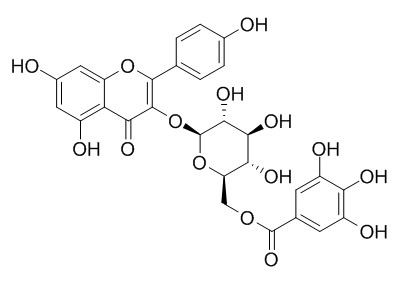Kaempferol 3-O-(6''-galloyl)-beta-D-glucopyranoside (Astragalin 6''-O-gallate)
Kaempferol 3-O-(6''-galloyl)-beta-D-glucopyranoside is an
α-glucosidase inhibitor with IC50 values between 0.6 and 22.4 μM.
Inquire / Order:
manager@chemfaces.com
Technical Inquiries:
service@chemfaces.com
Tel:
+86-27-84237783
Fax:
+86-27-84254680
Address:
1 Building, No. 83, CheCheng Rd., Wuhan Economic and Technological Development Zone, Wuhan, Hubei 430056, PRC
Providing storage is as stated on the product vial and the vial is kept tightly sealed, the product can be stored for up to
24 months(2-8C).
Wherever possible, you should prepare and use solutions on the same day. However, if you need to make up stock solutions in advance, we recommend that you store the solution as aliquots in tightly sealed vials at -20C. Generally, these will be useable for up to two weeks. Before use, and prior to opening the vial we recommend that you allow your product to equilibrate to room temperature for at least 1 hour.
Need more advice on solubility, usage and handling? Please email to: service@chemfaces.com
The packaging of the product may have turned upside down during transportation, resulting in the natural compounds adhering to the neck or cap of the vial. take the vial out of its packaging and gently shake to let the compounds fall to the bottom of the vial. for liquid products, centrifuge at 200-500 RPM to gather the liquid at the bottom of the vial. try to avoid loss or contamination during handling.
Evid Based Complement Alternat Med.2016, 2016:1230294
Molecules.2020, 25(15):3353.
Eur J Pharmacol.2024, 978:176800.
J Control Release.2021, 336:159-168.
Microchemical Journal2024, 200:110475
Molecules.2019, 24(16):E3003
Sustainability2021, 13(23),12981.
Nat Prod Sci.2018, 24(3):206
Korean j.of Pharm.2017, 70-76
Biomedicines.2021, 9(8):954.
Related and Featured Products
Journal of Functional Foods, 2018, 45:444-451.
Brazilian insulin plant as a bifunctional food: Dual high-resolution PTP1B and α-glucosidase inhibition profiling combined with HPLC-HRMS-SPE-NMR for identification of antidiabetic compounds in Myrcia rubella Cambess.[Reference:
WebLink]
Six species of Myrcia , commonly known as 'insulin plants' in Brazil, were assessed for their potential as functional foods.
METHODS AND RESULTS:
Thus, dual high-resolution α-glucosidase/PTP1B inhibition profiling and HPLC-HRMS-SPE-NMR analysis were used to identify the antidiabetic constituents of the crude ethyl acetate extract of M. rubella Cambess. A total of 31 compounds were identified, including seven α-glucosidase inhibitors with IC 50 values between 0.6 and 22.4 μM: 4,5-dicaffeoylquinic acid, isoquercitrin, quercetin-3- O -β- d -glucuronide,
Kaempferol 3-O-(6''-galloyl)-beta-D-glucopyranoside, quercetin-3- O -(6″-malonyl)-glucopyranoside, quercetin-3- O -(6″-( E )-feruloyl)-β- d -glucopyranoside, and quercetin-3- O -(2″-( E )-sinapoyl)-glucopyranoside as well as three strong PTP1B inhibitors with IC 50 values between 0.4 and 3.1 μM: kaempferol-3- O -α- l -rhamnoside, astragalin, and arjunolic acid.
CONCLUSIONS:
These results show that M. rubella is a potential bifunctional food for management of type 2 diabetes.



